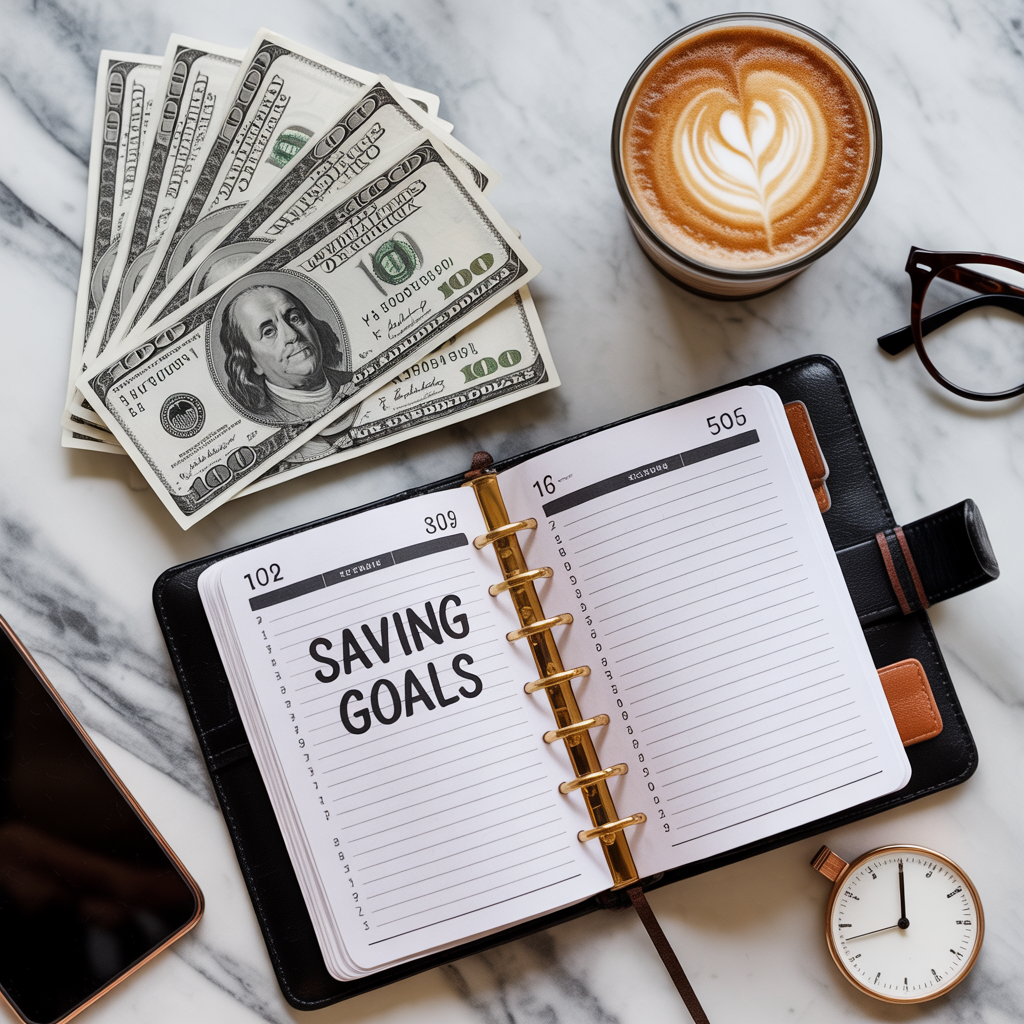7 Smart Financial Goals and Tips to Build Wealth After 40
Want to build wealth after 40? Learn financial life hacks like budgeting, debt payoff, and frugal living tips. From setting a saving money goal to learning how to get out of debt, these financial tips saving money help you create lasting financial stability.

Ever find yourself lying awake at night wondering if you’re actually on track with money—or if retirement is going to sneak up on you like that wrinkle you swear wasn’t there yesterday? Same. Once we hit 40, financial stability becomes less of a “someday” thing and more of a “girl, you better get it together” thing.
Here’s the truth: building wealth after 40 isn’t about winning the lottery or suddenly living off kale smoothies and side hustles. It’s about setting clear goals, making smart decisions, and creating a plan that actually works for your life.

Below, I’m sharing seven strategies that have not only worked for me but also for countless women who wanted more control over their money. Because at this stage? Financial literacy isn’t just nice to have—it’s survival.
👉 Ready to take the first step? Grab my free guide, 7 Money Rules You Must Learn Before It’s Too Late. It’s a simple, practical resource that will give you the financial tips saving money you wish you learned years ago.
Why Financial Literacy Matters After 40
Your 40s are like financial juggling hour—you might be paying a mortgage, saving for retirement, helping kids, or even caring for aging parents. And if no one ever really taught you how to manage money? You’re not alone. Financial literacy is the key that helps you handle all these moving pieces with a little more confidence and a lot less stress.
The Financial Education Gap for Women
Here’s a fun (and slightly depressing) fact: women are less confident in their money skills than men—even when studies show we often make smarter financial choices. Add in longer lifespans (hello, we have to stretch retirement funds further) and life interruptions like taking time off for kids or caregiving, and you’ve got unique money challenges stacked against you.
That’s why resources matter. A favorite of mine is the ebook How Money Works: For The Next Generation ($12). It’s the perfect gift for parents, grandparents, aunts, or uncles to pass down to the younger people in their lives. Because honestly? Teaching financial life hacks early helps everyone build financial stability later.

It’s Never Too Late to Learn About Money
Missed the “money 101” class in your 20s and 30s? Don’t sweat it. Starting in your 40s is still powerful. Learning how to get out of debt, save strategically, and invest wisely can completely change the game for your financial future. Age doesn’t disqualify you—it actually makes you sharper, because you know what you want (and what you don’t).
Resources Like "How Money Works - Stop Being a Sucker"
If you’re not sure where to start, I’ll point you straight to one of my favorite resources: How Money Works – Stop Being a Sucker. It breaks down confusing money topics in plain language and shows you how to avoid the traps that keep people broke. You can even check out a quick intro here.
Pair it with my Change Your Life free ebook for simple, frugal living tips and financial life hacks that can help you move from overwhelmed to organized.
Smart Financial Tips for Saving Money at Any Age
You don’t need a six-figure salary to start building wealth. What you do need are practical, repeatable habits that grow your money instead of draining it. Let’s talk about the ones that really work.
Create a Realistic Budget
A budget isn’t punishment—it’s a roadmap. When you know where your money is going, you stop wondering why your paycheck keeps disappearing. Creating a realistic budget makes you mindful of your habits and helps you line up your spending with your priorities.
The 50/30/20 Rule Explained
Want an easy formula? Try the 50/30/20 rule:
- 50% of your income = necessities (rent, groceries, utilities)
- 30% = fun stuff (dining out, hobbies, Target runs)
- 20% = saving + debt repayment
It’s one of the simplest financial tips saving money you can use to start building a money saving plan that sticks.
Apps That Make Budgeting Simple
Not into spreadsheets? Good news: there are apps that make budgeting painless. Mint, YNAB (You Need a Budget), and Personal Capital are some of the most popular. They track expenses, show you patterns, and keep you accountable with minimal effort. Total financial life hack.
| App | Features | Cost |
|---|---|---|
| Mint | Budgeting, bill tracking, credit score monitoring | Free |
| You Need a Budget (YNAB) | Budgeting, investment tracking, financial goal setting | $6.99/month or $83.99/year |
| Personal Capital | Financial planning, investment tracking, retirement planning | Free, with optional financial advisory services |

Build an Emergency Fund
If there’s one money habit that buys instant peace of mind, it’s this one. An emergency fund keeps life’s surprises—like car repairs or medical bills—from throwing you into debt. Think of it as financial self-care.
How Much You Really Need
The golden rule: 3–6 months’ worth of living expenses. For example, if your bills run $3,000 a month, aim for $9,000–$18,000 in your emergency stash. Adjust up or down depending on your job security and whether you have dependents.
👉 If you’re not sure where to start, my free 7 Money Rules guide walks you through step-by-step financial tips saving money to get that emergency fund going.
Eliminating Debt and Protecting Your Future
Debt in your 40s can feel like dragging an anchor uphill. But the faster you deal with it, the lighter and freer you’ll feel—not just financially, but emotionally too.
Tackle High-Interest Debt First
High-interest debt (hello, credit cards) bleeds you dry the fastest. By focusing here first, you stop wasting money on interest and finally get out of debt quicker.
Debt Snowball vs. Debt Avalanche Methods
There are two main ways to tackle debt: the debt snowball and the debt avalanche. The debt snowball method pays off small debts first. The debt avalanche method targets high-interest debts first.
| Method | Description | Pros | Cons |
|---|---|---|---|
| Debt Snowball | Pay off debts with the smallest balances first | Quick wins, psychological boost | May not be the most cost-effective |
| Debt Avalanche | Pay off debts with the highest interest rates first | Saves money on interest, cost-effective | May take longer to see results |
The debt snowball gives quick wins and a psychological boost. The debt avalanche saves more on interest but takes longer. Pick whichever one keeps you motivated-because staying consistent is the ultimate financial life hack.

Protect Your Assets with Insurance
Paying off debt is step one. Step two? Protecting what you’re building. Insurance is your safety net when life throws curveballs.
Types of Insurance Every Woman Over 40 Should Consider
Women over 40 should think about several insurance types. These include:
- Life insurance
- Disability insurance
- Long-term care insurance
- Health insurance
It's not glamorous, but it's what keeps your financial stability intact when the unexpected happens.
Investment Strategies to Accelerate Wealth Building
At this stage, your money should be working as hard as you are. Smart investments grow your wealth and bring you closer to the freedom you want.
Maximize Retirement Contributions
Every dollar you contribute to retirement accounts now reduces your taxable income and builds your future nest egg. Don’t leave free money (like employer matches) on the table.
Diversify Your Investment Portfolio
All your eggs in one basket? Bad idea. Spread your investments across different asset types so one bad year in the stock market doesn’t wreck your financial life.
Creating Additional Income Streams
Want to fast-track your goals? Add more income. Side hustles and passive income streams are like giving your financial plan rocket fuel.

Develop Passive Income Sources
Passive income is a smart way to earn more without working hard. You can invest in stocks, real estate, or peer-to-peer lending. This way, you make money while you sleep (yes, really), improving your financial health.
Some top passive income ideas are:
- Creating and selling online courses or ebooks
- Affiliate marketing
- Renting out a spare room on Airbnb
Side Hustles That Can Become Full-Time Income
Some “extra cash” gigs turn into legit careers. Think freelance writing, graphic design, or consulting. Start small, build skills, and see where it takes you.
Examples of successful side hustles are:
- Freelance writing or editing services
- Selling handmade products on platforms like Etsy
- Offering virtual assistant services
Turning Hobbies Into Profit
Love photography, music, or crafting? Turn that passion into income. Sell online, teach classes, or license your work. Earning money from what you enjoy is the ultimate financial life hack.
Some ideas for making money from hobbies are:
- Selling your work on online marketplaces
- Offering lessons or workshops
- Licensing your work or products

By trying these ideas, you can improve your finances and reach your goals. Find what works for you and enjoy the journey.
Your Path to Financial Freedom After 40
Here’s the bottom line: financial freedom after 40 isn’t about perfection—it’s about progress. By following these seven strategies, you’ll set yourself up with a realistic budget, an emergency fund, a debt plan, insurance protection, and smart investments.
Add in a few income streams, and suddenly you’re not just surviving—you’re thriving with financial stability.
👉 Start today with the free 7 Money Rules guide to get your foundation in place.
👉 Want to inspire the younger generation? Gift them How Money Works: For The Next Generation—the $12 ebook that makes money simple.
👉 Or grab my Change Your Life free ebook for financial tips saving money and frugal living tips you can use right now.
Because once you start making these shifts, you’ll realize—you’re not just building wealth after 40, you’re building the financial future you deserve.
FAQ
What are the first steps to building wealth after 40?
To start building wealth after 40, first make a realistic budget. Then, tackle high-interest debt and build an emergency fund. These steps will help you achieve financial stability and set you up for long-term success.
How can I get out of debt and stay debt-free?
To get out of debt, use the debt snowball or debt avalanche method. This means tackling high-interest debt first. Consider consolidating debt into a lower-interest loan or balance transfer credit card. To stay debt-free, avoid new debt and keep a budget that includes savings and emergency funding.
What are some frugal living tips that can help me save money?
Effective frugal living tips include cooking at home and canceling unused subscriptions. Also, shop during sales and use cashback apps. Reduce energy consumption and do DIY projects instead of hiring professionals.
How much should I save in an emergency fund?
I recommend saving 3-6 months' worth of living expenses in an easily accessible savings account. This fund helps cover unexpected expenses, avoids debt, and keeps your finances stable.
What are some financial tips for saving money on a fixed income?
To save on a fixed income, use the 50/30/20 rule. Allocate your income for necessities, discretionary spending, and savings. Reduce expenses, use senior discounts, and take advantage of tax-advantaged savings vehicles.
How can I maximize my retirement contributions?
To maximize retirement contributions, take advantage of catch-up contributions after age 50. Contribute as much as possible to tax-advantaged retirement accounts like 401(k) or IRA. Consider consulting a financial advisor to optimize your retirement strategy.
What are some alternative investment options beyond stocks?
Alternative investment options include real estate, peer-to-peer lending, and dividend-paying investments. You can also invest in a robo-advisor or a tax-efficient portfolio. This diversifies your investments and helps achieve financial stability.
How can I turn my hobbies into a source of income?
To turn hobbies into income, identify your marketable skills. Consider freelancing, selling products online, or teaching others. You can also start a side hustle or small business that uses your hobbies and interests.
Affiliate Disclaimer
This blog may contain affiliate links, which means I may earn a small commission if you click on a link and make a purchase—at no extra cost to you. As an affiliate, I only recommend products that I personally use, trust, and believe will add value to my readers. Your support helps keep this content free and allows me to continue sharing helpful tips and resources.
I am not a medical professional, and the information provided on this blog is for educational and informational purposes only. Always consult with a qualified healthcare provider before making any changes to your skincare or wellness routine.